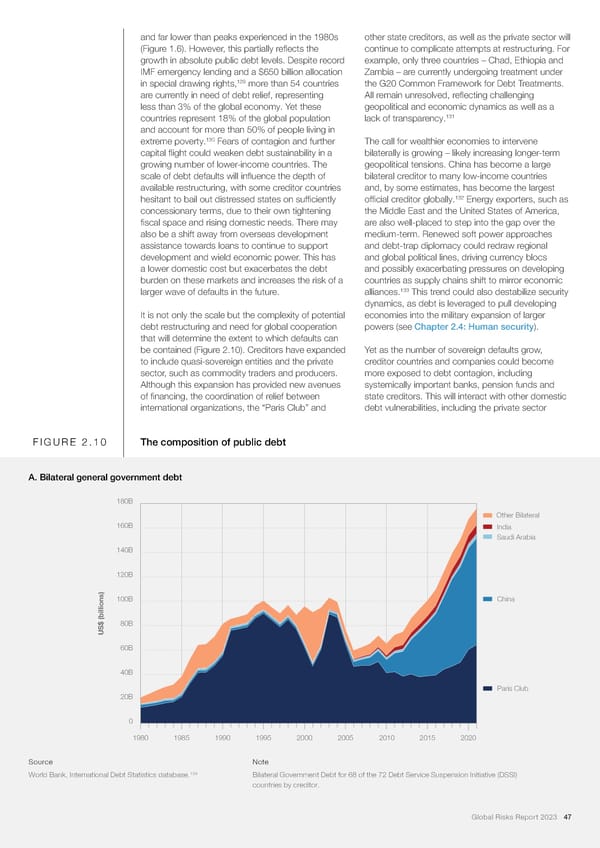and far lower than peaks experienced in the 1980s other state creditors, as well as the private sector will (Figure 1.6). However, this partially re昀氀ects the continue to complicate attempts at restructuring. For growth in absolute public debt levels. Despite record example, only three countries – Chad, Ethiopia and IMF emergency lending and a $650 billion allocation Zambia – are currently undergoing treatment under 129 in special drawing rights, more than 54 countries the G20 Common Framework for Debt Treatments. are currently in need of debt relief, representing All remain unresolved, re昀氀ecting challenging less than 3% of the global economy. Yet these geopolitical and economic dynamics as well as a 131 countries represent 18% of the global population lack of transparency. and account for more than 50% of people living in 130 extreme poverty. Fears of contagion and further The call for wealthier economies to intervene capital 昀氀ight could weaken debt sustainability in a bilaterally is growing – likely increasing longer-term growing number of lower-income countries. The geopolitical tensions. China has become a large scale of debt defaults will in昀氀uence the depth of bilateral creditor to many low-income countries available restructuring, with some creditor countries and, by some estimates, has become the largest 132 hesitant to bail out distressed states on suf昀椀ciently of昀椀cial creditor globally. Energy exporters, such as concessionary terms, due to their own tightening the Middle East and the United States of America, 昀椀scal space and rising domestic needs. There may are also well-placed to step into the gap over the also be a shift away from overseas development medium-term. Renewed soft power approaches assistance towards loans to continue to support and debt-trap diplomacy could redraw regional development and wield economic power. This has and global political lines, driving currency blocs a lower domestic cost but exacerbates the debt and possibly exacerbating pressures on developing burden on these markets and increases the risk of a countries as supply chains shift to mirror economic larger wave of defaults in the future. alliances.133 This trend could also destabilize security dynamics, as debt is leveraged to pull developing It is not only the scale but the complexity of potential economies into the military expansion of larger debt restructuring and need for global cooperation powers (see Chapter 2.4: Human security). that will determine the extent to which defaults can be contained (Figure 2.10). Creditors have expanded Yet as the number of sovereign defaults grow, to include quasi-sovereign entities and the private creditor countries and companies could become sector, such as commodity traders and producers. more exposed to debt contagion, including Although this expansion has provided new avenues systemically important banks, pension funds and of 昀椀nancing, the coordination of relief between state creditors. This will interact with other domestic international organizations, the “Paris Club” and debt vulnerabilities, including the private sector FIGURE 2.10 The composition of public debt A. Bilateral general government debt 180B Other Bilateral 160B India Saudi Arabia 140B 120B 100B China 80B US$ (billions) 60B 40B Paris Club 20B 0 1980 1985 1990 1995 2000 2005 2010 2015 2020 Source Note World Bank, International Debt Statistics database.134 Bilateral Government Debt for 68 of the 72 Debt Service Suspension Initiative (DSSI) countries by creditor. Global Risks Report 2023 47
 2023 | Global Risks Report Page 46 Page 48
2023 | Global Risks Report Page 46 Page 48